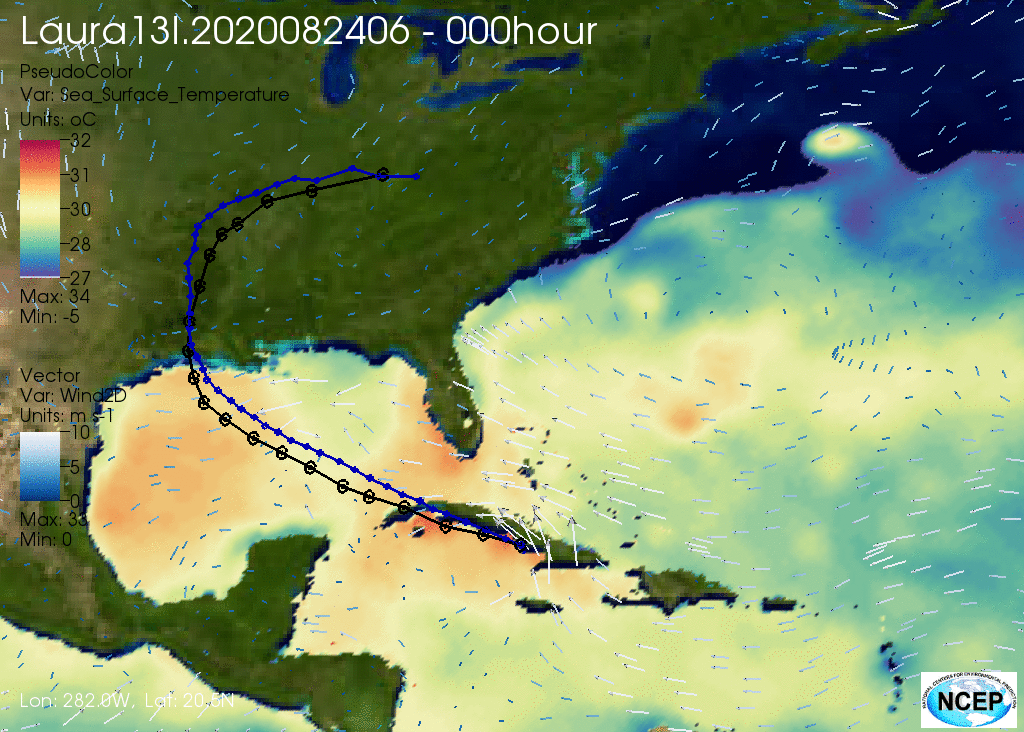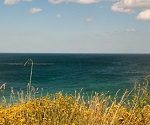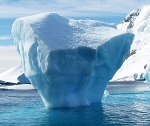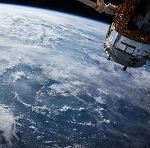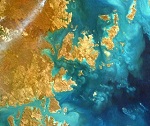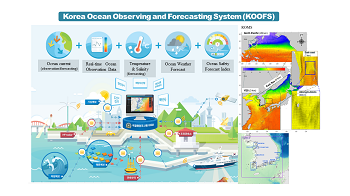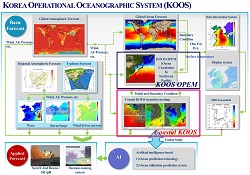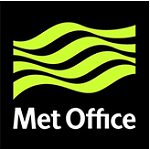Newsletter Dec 2021
You can download this newsletter as pdf
 Newsletter 1
Newsletter 1
December 2021
Figure: 3D-animation of coupled experimental Hurricane Analysis and Forecast System (HAFS) for Hurricane Laura prior to landfall on Gulf of Mexico coast in August 2020. The ocean model states are derived from RTOFS nowcast and forecasts. The model forecast track (in blue) matches well with NCEP/NHC’s best track (in black). Upwelling caused by the storm can be seen in cooler SST’s near the storm vortex.
Example of an application of an operational forecasting system. Read more about RTOFS below.
Content
- ForeSea – The OceanPredict UN Decade Programme
- OP Task Team News
- OP Operational Ocean Forecasting System News
- General OP News
- Events (recent and upcoming)
- Contact
ForeSea – The OceanPredict programme for the UN Decade of Ocean Science
OceanPredict supports the UN Decade of Ocean Science through the UN Decade endorsed programme ForeSea, whose vision is for strong international coordination and community building of an ocean prediction capacity for the future. The overarching goals are to
- Improvement of the science, capacity, efficacy, use, and impact of ocean prediction systems and
- Building of a seamless ocean information value chain, from observations to end users, for economic and societal benefit. These transformative goals aim to make ocean prediction science more impactful and relevant.
ForeSea will be supported by SynObs, a UN Decade project (to be endorsed) which seeks to extract the maximum benefit from combinations of different observation platforms in the ocean observing network, typically of in-situ and satellite observations, for ocean state (including sea-ice and BGC properties) monitoring and predictions using ocean prediction.
The ForeSea Steering Committee has been set up and a first committee meeting was held on 19 Nov 2021. A Co-advisory Committee for ForeSea, ObsCoDe and CoastPredict is being considered and will allow for closer collaboration between a number of UN Decade programmes. Currently, ForeSea participates in the 2nd call of the UN Decade actions and will be interested to learn of further projects (besides SynObs) to support its aims.
In the framework of the UN Decade, ForeSea will collaborate with other UN Decade programmes, like DITTO, OASIS and Marine Life 2030. It is also involved with the US national initiative for the UN Decade that will align and support OceanPredict and associated proposed UN Ocean Decade programmes and efforts. The “Ocean Shots” can be viewed on the Ocean Decade U.S. website.
OP Task Teams

OceanPredict contributes to the development of new science capabilities through active working groups, called the OP Task Teams (or TTs). OceanPredict currently operates six different task teams, which are all working in exiting science areas, complementing each other. They collaborate and reach out to external science and research communities, linking OceanPredict into an international ocean science landscape:
- Coastal Ocean and Shelf Seas TT (Villy Kourafalou, University of Miami/RSMAS and Pierre De Mey-Frémaux, CNRS/LEGOS)
- Coupled Prediction TT (Chris Harris, Met Office, Santha Akella, NASA, Kristina Mogensen, ECMWF)
- Data Assimilation TT (Matt Martin, Met Office and Andy Moore, UCSC)
- Intercomparison and Validation TT (Fabrice Hernandez, IRD and Greg Smith, ECCC)
- Marine Ecosystem Analysis and Prediction TT (Katja Fennel, Dalhousie University and Stefano Ciavatta, PML)
- Observing System Evaluation TT (Elisabeth Remy, Mercator Ocean International and Yosuke Fujii, MRI/JMA)
Brief updates of current activities in the COSS-TT, CP-TT, OS-Eval TT and DA-TT
COSS-TT (Coastal and Shelf Seas Task Team): Since its last meeting in September 2018 (in Madrid) the TT reached out to new partners and is now deeply involved in the UN Decade of Ocean Science (“Ocean Decade”) – see previous article. The COSS-TT made major contributions to the preparation of the goals and actions of the ForeSea and CoastPredict programmes, which are now officially UN Decade endorsed.
The TT will continue to play a vital role in their execution, including in affiliated projects, such as SynObs. The last COSS-TT meeting was held in June 2021 (virtually) to engage TT members on the related Ocean Decade activities. The next general COSS-TT meeting is planned on 11-13 April 2022 in Montréal, Canada. We currently aim to run that meeting in hybrid format.
(Pierre De Mey-Frémaux and Villy Kourafalou, COSS-TT co-chairs)
In the meantime, they are providing CP-relevant input to OceanPredict and associated meetings with Santha having joined the ForeSea steering committee and Kristian attending the recent SynObs discussions. Chris and Santha are also on the organising committee for the delayed joint OS-Eval/CP symposium in Tsukuba, Japan.
(Chris Harris, CP-TT co-chair)
OS-Eval TT (Observing System Evaluation Task Team): The OS-Eval TT is currently preparing the submission of SynObs as a to-be endorsed UN Decade projects through the 2nd call for UN Decade Actions. This happens in parallel to preparing the launch of SynObs, which requires communication with GOOS, the Observing System Co-design leads, and the OPST & TT chairs, to discuss and agree on steering team members and prepare the SynObs implementation plan.
Recently the OS-Eval TT released a “table of observation use” in the OceanPredict systems, and started the OSE collaboration for the assessment of the Argo fast salinity drift. OS-Eval TT online meetings are held every 2 or 3 months.
(Yosuke Fujii and Elisabeth Remy, OS-Eval-TT co-chairs)
DA-TT (Data Assimilation Task Team): The DA-TT held a joint workshop with ECMWF on Advances in Ocean Data Assimilation from 17-20th May 2021. More than 170 scientists from around the world presented recent progress and challenges ahead in ocean data assimilation in a virtual event. Recordings of the presentations, working group reports, and other information ahead in ocean data assimilation in a virtual event. Recordings of the presentations, working group reports, and other information are available on the workshop’s website.
Since then a technical seminar series has been initiated with attendees invited mainly from the DA-TT and OS-Eval TT. The first of these was held in September and they will continue every two months. DA-TT members also had a presence at the recent WCRP-WWRP DA Symposium and were involved in its organization.
(Matt Martin and Andy Moore, DA-TT co-chairs)
OP Systems
The current operational forecasting systems linked to OceanPredict range from basin-scale to global coverage and from low to eddy-resolving resolutions. Most of the systems assimilate real-time observations and provide daily short-term forecast. Their products are available through web services.
Latest news from seven of the OceanPredict operational systems (more online)
US, RTOFS – The global operational Real-Time Ocean Forecast System (Global RTOFS version 2 with data assimilation) at the National Centers for Environmental Prediction (NCEP) is based on an eddy resolving 1/12° global HYCOM (HYbrid Coordinates Ocean Model) coupled to Los Alamos sea CICE and is part of a larger national backbone capability of ocean modelling at the National Weather Service, developed in a strong partnership with the US Navy. RTOFS-v2 was made operational at NWS/NCEP in December 2020.
Satellite Sea Surface temperature, Sea Surface Salinity, Absolute Dynamic Topography, surface in-situ observations and ocean profiles are all assimilated. Ocean states and forecasts from RTOFS are used for providing initial and boundary conditions for the operational and experimental Hurricane prediction systems (HWRF, HMON, HAFS) at NWS/NCEP. NOS’s coastal ocean forecast systems (e.g. WCOFS) and IOOS regional ocean forecast systems also use RTOFS results for initialization (also see animation on page 1).
(Avichal Mehra, NOAA/NCEP)
Australia – OceanMAPS version 3.4 went operational in May 2021. The system introduced a two-stage ensemble optimal interpolation method, as well as other changes. The first stage is performed using an ensemble of monthly anomalies from a coarse resolution (1°) model using a localization length scale, 1600 km.
The strategy effectively leverages Argo profiles to reduce systematic errors in the basin-wide thermocline. CLASS4 verification against Argo demonstrates gains persist into the forecast. OceanMAPS was used by the US Coast Guard to achieve a successful search and rescue of two fisherman in the Federated States of Micronesia in February 2021.
(Gary Brassington, BoM)
The Japan-area model is initialized using the 4DVAR model fields by IAU downscaling. The high-resolution surface current data provided by the system have been utilized to select the optimum ship routing for fishing boats around Japan so as to reduce fuel cost.
(Goro Yamanaka, MRI-JMA)
Italy – The Mediterranean OP systems (CMCC+OGS):
Two Italian OP systems provide analyses and 10-day forecasts of the main physical (CMCC https://medfs.cmcc.it/) and biogeochemical (OGS http://medeaf.inogs.it/) parameters for the Mediterranean within the Copernicus Marine Service (https://marine.copernicus.eu/). The physical, based on a coupled NEMO-WW3 configuration, and the biogeochemical systems, based on the coupled OGSTM-BFM model, have 1/24o horizontal resolution, are forced by ECMWF HR atmospheric fields and assimilate satellite SST, SLA and Ocean Color, and Temperature, Salinity, Chlorophyll and Nitrates profiles. Recently, the explicit representation of tides has been included and an improved representation of the river inputs is planned from December 2021.
The Global Ocean Forecasting systems at 1/16 (CMCC):
The eddying Global Ocean Forecasting System (GOFS16) provides analyses and 7-day forecasts of the main physical parameters on a daily basis (https://gofs.cmcc.it/). Physical and assimilation components work at 1/16° horizontal resolution corresponding to 6.9 km at the equator and increasing up to roughly 3 km in the polar regions. Hydrographic in-situ profiles are assimilated together with satellite SLA and SST. A web-based verification tool for the analyses against Argo floats is routinely updated (https://evalid.cmcc.it/evaluation/gofs/). Next planned developments consider the use of ECMWF atmospheric forcings at 1/10°, the inclusion of new model physics (NEMOv4) and the assimilation of sea-ice variables.
(Simona Masina, CMCC)
Republic of Korea – KHOA and KIOST: Two major Korean institutes, KHOA and KIOST have operated the ocean circulation forecasting systems (regional, sub-regional, coastal areas, and port areas) called KOOFS and KOOS since 2012 and 2009, respectively. These systems have been used to mitigate Korean coastal-ocean maritime disasters, including via search and rescue, oil spill and marine litter clean-up support.
In 2021 KHOA began operating the Ulleungdo-Dokdo sub-coastal model, nested through an off-line technique within the East Sea model. In January 2021 KIOST, model, nested through an off-line technique within the East Sea model. In January 2021 KIOST transferred the Coastal KOOS to the company Korea Shipbuilding & Offshore Engineering, the global leader in shipbuilding and offshore business.
(Do-Seong Byun, KHOA)
India – Indian National Centre for Ocean Information Services (INCOIS), India is the nodal agency that provides ocean state analysis and forecasts of the Indian Ocean. It employs a Local Ensemble Transform Kalman Filter (LETKF) in the operational model – Regional Ocean Modeling System. Using 80 ocean ensemble members forced by 80 atmospheric fluxes, it
provides ocean analysis at a resolution of ~ 8 km called Regional Analysis of Indian Ocean (RAIN). It assimilates all available in-situ temperature and salinity profiles and satellite data of sea surface temperature from GHRSST. RAIN is extensively used by the coast guards in search and rescue operations.
(Arya Paul, INCOIS)
UK – The FOAM suite comprises global 1/12° ocean-ice and 1/4° coupled ocean-ice-atmosphere-land forecasting systems, and regional systems coupling ocean physics to waves and biogeochemistry. All systems use NEMO for ocean physics and NEMOVAR for 3D-Var data assimilation. Many products are available from CMEMS, applications include seasonal forecast initiation, search and rescue, and oil spill response.
From February 2022, global Met Office weather forecasts will come from the coupled system, and UK weather forecasts now use high-resolution regional sea surface temperature forecasts. Ocean colour assimilation has recently been added for biogeochemistry, and planned developments include hybrid ensemble-variational data assimilation and assimilating remotely sensed salinity and currents.
(David Ford, Met Office)
General OP News
- OceanPredict strategy update – the OP strategy has been finalized internally and is now awaiting external review by programme partners
- OceanPredict office collaborations with G7/FSOI and GEO Blue Planet – regular meetings take place between the OP, G7/FSOI and the GBP offices for mutual support and to exchange collaboration (e.g. Decade Collaboration Centre-DCC), programme governance and project plans.
- A recent survey was conducted to collect information on the use of core, BGC and deep Argo in operational systems under OceanPredict.
- Publication list – OceanPredict will maintain a publication list on the OP website which will be updated quarterly.
Recent and Upcoming OP events
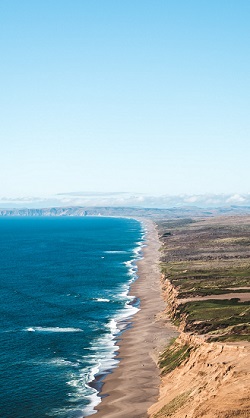
ForeSea Steering Committee meeting (19 Nov 2021) was the first meeting of the new steering committee at which priorities of ForeSea activities were discussed.
IV-TT internal meeting (22 Nov 2021) discussed potential contributions of the task team to the UN Decade and related OceanPredict efforts (ForeSea, Coastspredict, SynObs, …) Recent progress with the new Class-4 intercomparison project using drifter observations was also on the agenda.
OS-Eval TT internal meeting (23 Nov 2021) focused on fishing vessel observations, deep Argo data reporting, and the SynObs application to the UN Decade.
DA-TT technical seminar series (2) (29 Nov 2021, by invitation only) showed a presentation by Matt Martin (Met Office) on “Developing the assimilation of satellite total surface current velocities”. Information is available on request.
The OceanPredict Science Team (OPST-5) meeting took place on 6-8 Dec 2021 as a virtual event. The focus was on the national system progress, their interaction with the TTs and OP’s involvements with the UN Decade.
The next COSS-TT International coordination meeting (9), 11-13 April 2022 will be a first hybrid meeting of OP with face-to-face activities. The meeting will take place in Montréal, Canada.
An EuroSea/OceanPredict workshop is planned in June 2022. This workshop will provide an opportunity for the large EU funded project EuroSea to engage with OP task teams and the wider OP community to explore observing system design in a global context.
Upcoming international events
Upcoming event in 2021/22 (OP events marked orange):
| February / March 2022 | April 2022 | June 2022 |
|---|---|---|
| Ocean Sciences Meeting (OSM) 2022, 27 Feb – 4 March 2022, Honolulu, USA, hybrid | 9th International Coordination meeting of the COSS-TT (ICM9), 4-8 April, Montreal, Canada, hybrid | EuroSea/OceanPredict workshop on Observing system design, 21-23 June 2022, Met Office, UK, hybrid |
Events organised in other communities relevant for OceanPredict:
Contact
OceanPredict Programme Office Follow us on Twitter or Sign up with OceanPredict
Met Office
FitzRoy Road
Exeter, EX1 3PB
United Kingdom
Manage your subscriptions
Sign up to receive news and event information about OceanPredict
